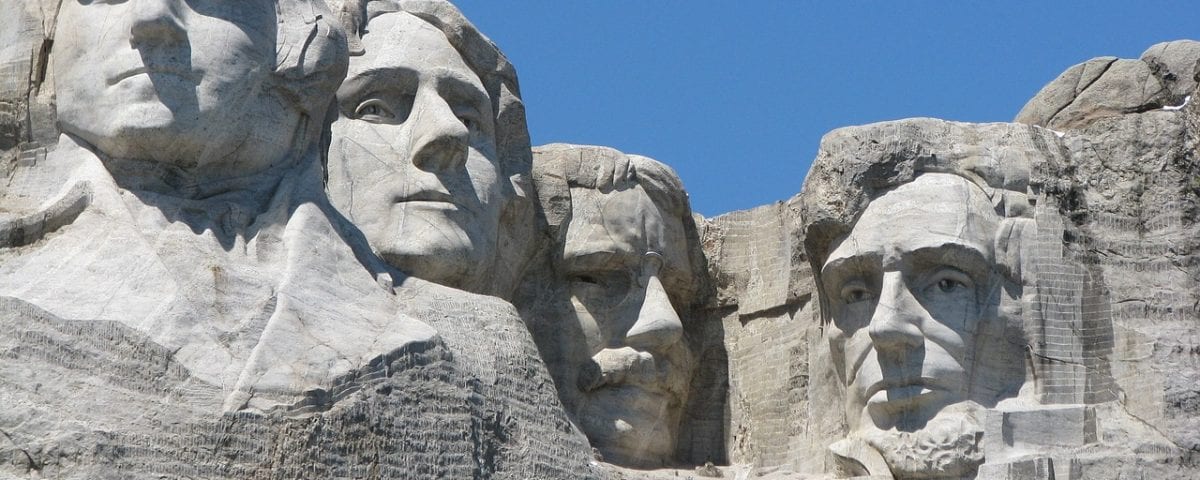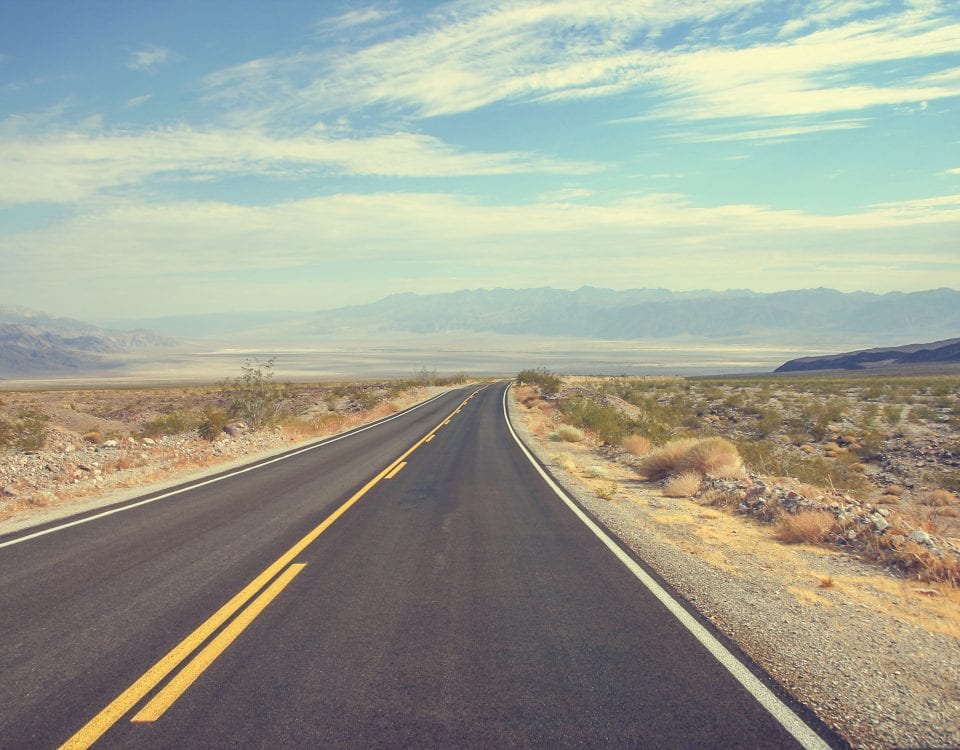
Day 51: Entering the Wild West
May 9, 2021
Day 49: Little Houses, Big Farms in the Dakotas
May 7, 2021Most recently updated on February 20, 2024
Originally posted on May 8, 2021
It’s a 5-hour drive straight west on Interstate 90 today as we leave Sioux Falls with the vastness and quirkiness of southern South Dakota ahead.
Interstate 90 is the longest freeway in the United States at 3,020 miles. Construction on it started in 1956 with the last segment being finished in 1993.
It goes west to east from Seattle to Boston as it travels through 13 states. They are Washington, Idaho, Montana, South Dakota, Wyoming, Minnesota, Wisconsin, Illinois, Indiana, Ohio, Pennsylvania, New York and Massachusetts. The larger cities include Seattle, Spokane, Billings, Rapid City, Sioux Falls, Madison, Chicago, Cleveland, Buffalo and Boston.
We won’t be seeing many big or even mid-sized towns between Sioux Falls and Rapid City on today’s journey.

South Dakota is the 46th most populated state with almost 930,000 residents. Only Wyoming, Vermont, Alaska and North Dakota have fewer people. Only two cities in South Dakota have more than 30,000 residents. Nearly 350 have fewer than 10,000. The state capital of Pierre has less than 14,000 people. That’s the second smallest population of any state capital.
This sparse population comes despite the fact South Dakota has the highest birth rate of any state with 68 births per 1,000 residents.
The state is named after the Lakota and Dakota Sioux tribes. It’s bisected by the Missouri River. South Dakotans refer to the two halves of the state as “East River” and “West River.” The east side is home to most of the population. Farming is dominant on the east side and ranching is dominant on the western sector along with tourism and defense spending. Most of the Native American reservations are in the western half.
The first European explorers came through in 1743, In 1762, the region became part of Spanish Louisiana. The United States acquired most of South Dakota in the 1803 Louisiana Purchase. Yes, that transaction with France stretched this far northward and westward.
In 1817, a fur trading post was established at Fort Pierre. In 1858, the Yankton Sioux signed a treaty, giving most of eastern South Dakota to the U.S. government. The Dakota Territory was officially established in 1861. It included both Dakotas and parts of present day Wyoming and Montana.
Settlement increased rapidly after the 1862 Homestead Act, especially after a major railroad was established in 1873. In 1874, gold was discovered in the Black Hills during an expedition led by General George Custer. This occurred even though the Sioux had been granted rights to the region in an 1868 treaty. In 1980, the U.S. Supreme Court ruled that the United States owed Native American tribes monetary damages for the illegal seizure of the land and mining rights. However, the Lakota refuse to accept damages and instead insist on the return of the land.
The Dust Bowl disaster hit the region in the 1930s due to drought and poor farming practices. Bank closures and the Great Depression also devastated the state. The population declined 7 percent from 1930 to 1940. Things improved after the United States entered World War Two due to demand for South Dakota agricultural and industrial products.
The economy has diversified the past 60 years. The interstate highway system in the 1960s helped tourism. Financial services have increased, in particular with the Citibank move from New York to Sioux Falls in 1981.
The service industry is also an economic contributor, led by finance, retail and healthcare. The top manufacturing products are computer components followed by food processing. Government spending is also a driver and tourism is also important, especially Mount Rushmore.
In 2007, the site of the Homestead gold mine near Lead, northwest of Rapid City, was converted to the Sanford Underground Research Facility, the deepest underground laboratory in the United States. Workers at the complex do experiments on dark matter and neutrino research.
Nonetheless, agriculture remains the number one industry. There is an estimated 43 million acres of farmland in South Dakota, almost 90 percent of the state’s land. Nearly 30,000 farms are here with an average size of 1,400 acres. It’s estimated that 98 percent of farms in South Dakota are family-owned and 2,500 farms have been in the same family for more than 100 years. The top crops are corn, soybeans, hay and wheat.
South Dakota has also experienced some “rural flight” as younger, more educated people in particular move to cities to seek greater opportunities.
Sculptures, Hail, Missiles and Nomadland
There’s all sorts of rural ahead of us on I-90.
One of the first towns we encounter is Montrose, a community of less than 500 people just a half-hour west of Sioux Falls.

The Porter Sculpture Park outside Montrose, South Dakota. Photo by Ghosts of North America.
What brings us here today is some metal sculptures.
The Porter Sculpture Park is a 10-acre compound just outside Montrose with 50 metal sculptures, including a 60-foot-high bull head and a 24-foot-tall horse, which 183 people donated $18,000 to help move the 40-ton work.
Wayne Porter is the sculptor and park operator. He grew up on a farm in Handy County, then moved with his family to nearby St. Lawrence when he was 4. His father was a blacksmith and Porter hung around the shop as a child.
Porter crafted his first sculpture when he was 10. He learned to weld when he was 12. Porter graduated from high school in 1978 and then completed a degree at South Dakota State University. He subsequently dropped out of law school to come back and work in his dad’s blacksmith shop and raise sheep.
His first sculptures were placed outside the blacksmith shop. People started driving by to see the artwork. When Porter had enough art he decided he wanted to open a park. He found some land that was available and made it happen.
—————————-
Next on the small town parade in southern South Dakota is Vivian.
The community of 50 people is two hours west of Montrose along Interstate 90. The town has a median age of 64 and it’s officially listed as 100 percent white. It has a median annual household income is about $60,000. A home will cost you on average $136,000. The town sits at an altitude of 1,950 feet.
The first settler established a store and post office in 1892. The Milwaukee Railroad arrived in 1907. The town was named after Vivian Hunter, the wife of a railroad official. The Vivian Dance Hall used to be part of an active downtown here.
The community’s claim to fame is the U.S. record hailstone that fell on the town on July 23, 2010. The ball of frozen ice was 8 inches in diameter, 18 inches in circumference and weighed 1 pounds 15 ounces. Other hailstones that day damaged homes as well as busted windshields on cars, including vehicles on Interstate 90. The hailstone might have been bigger when it first fell, but authorities said the rancher who found it kept opening his freezer to look at it.
Vivian also has a TA Coffee Cup Fuel Stop. The service station franchise began in 1981 in Steele, North Dakota. There are now 10 places in North Dakota, South Dakota and Wyoming, including the Vivian locale. The franchises do charity work that includes the St. Christopher’s Truckers Development & Relief Fund, which provides financial assistance to truckers whose medical issues have led to economic hardship.
—————————
Our next stop is a half-hour west of Vivian.
The town of Murdo also has less than 500 residents with a median annual household income of $53,000. The average price of a home is about $90,000. The median age is 47. The elevation has risen to 2,316 feet here.
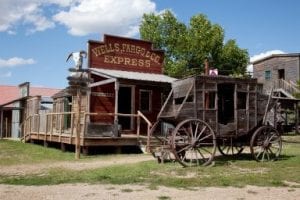
The 1880s Town in Murdo, South Dakota. Photo by Library of Congress.
The community was founded in 1906 by the Chicago, Milwaukee, St. Paul and Pacific Railroad. The town had a roundhouse, a rail yard and a passenger station. It was named after Murdo MacKenzie, a cattleman who shipped Texas steers to the Dakotas.
The town grew quickly after the railroad came with 40 businesses, including five restaurants, three drug stores, a furniture store and a lumber yard. It had more than 10,000 residents by 1910.
The 1880 Town, a family-owned heritage village 20 miles west of Murdo has re-created what life was like for South Dakota pioneer families. The site has 30 buildings from the era between 1880 and 1920, including a blacksmith shop, one-room schoolhouse, a jail and a saloon. There’s also a 1950s train diner as well as a museum for Casey Tibbs, a nine-time champion rodeo cowboy born in South Dakota. The complex also has props from the movie “Dances With Wolves,” which was filmed entirely in South Dakota.
Murdo is where the Central and Mountain Time Zones meet. Murdo is in the Central Time Zone, so as we depart and head west on I-90 we leave the Central Zone after 10 days and enter Mountain Time for the first time since we left New Mexico on Day 5.
—————————————
Not too far west of Murdo is a remnant of the United States’ Cold War with the Soviet Union in the 1950s and 1960s.
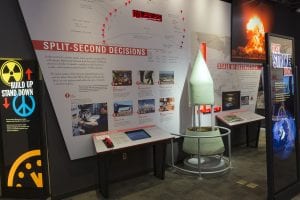
The Minuteman Missile National Historic Site. Photo by Travel South Dakota.
The Minuteman Missile National Historic Site is located on a 15-mile stretch along Interstate 90 near the Badlands Loop on the way to Rapid City.
The historic site contains a visitors center and two missile silos named Delta-01 and Delta-09. Both were decommissioned after 1991 agreement between the United States and the Soviet Union. An inoperative missile still sits in one of the silos, which were operational from 1963 to 1999. There are also historical displays on the Cold War and the development of ICBMs. The park houses the last Minuteman II system in the United States.
It’s the only historic site run by National Parks related to the Cold War. It was established as a historic site in 1999. Its purpose is to tell the history and importance of nuclear deterrent during the Cold War.
These two sites were part of 15 launch control facilities that commanded 150 missile silos across 13,500 square miles of southwestern South Dakota. The Great Plains had 1,000 nuclear missiles, including 150 in western South Dakota.
—————————————
An 80-foot-high, 50-ton concrete dinosaur greets you as you arrive at Wall, a town of slightly less than 700 people about an hour west of Murdo along Interstate 90.
However, the dinosaur is not the main attraction here. You would know that if you closely watched “Nomadland,” the 2021 winner of the Oscar for best motion picture. Wall is where the character Fern spends part of her wandering travels.
Wall was established as a railroad town in 1907 for the Chicago/Northwestern Railroad. It was named after the nearby northern wall of the Badlands region.
The town only had 300 residents in the 1930s but then grew after a road was built to the Badlands National Park.
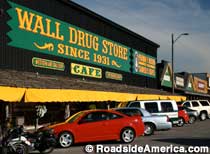
The Wall Drug Store in South Dakota that was featured in the movie “Nomadland.” Photo by Roadside America.
It also grew due to the Wall Drug Store, a business that was purchased in 1931 by Ted Hustead. He and his wife, Dorothy, barely kept the store going for five years when in 1936 she came up with the idea of offering the motorists speeding by on I-90 some free ice water. They put up signs along the highway advertising the free water and people have been coming ever since. It’s the place where Fern works for a spell in the film.
Inside the complex are dining facilities, a soda fountain, bars and the Western Art Gallery Restaurant with 500 seats and 300 oil paintings. The store still offers free ice water and a 5-cent cup of coffee. They provide free coffee and doughnuts to military personnel who travel through. The store will get 2 million visitors in a typical year
Due to its freeway location near Mount Rushmore, the town can get as many as 20,000 visitors a day during the busy tourist season. Wall serves as a trade center for farmers and ranchers, mainly for hay, wheat and beef.
The town is also home to Wounded Knee: The Museum. The facility, which has had lengthy closures during the COVID-19 pandemic, is a memorial to those killed at Wounded Knee Creek on December 28, 1890. In that battle, the U.S. Calvary killed 146 Sioux Tribe members at Wounded Knee on the Pine Ridge Reservation. In addition, 25 Calvary members were killed. About two weeks before, reservation police had killed Sitting Bull while trying to arrest him. The arrest came amid rising concerns by U.S. officials about the “Ghost Dance” principles believed by Sioux tribe members.
In 1973, there was a 71-day occupation of the Wound Knee site by the American Indian Movement to protest treaty violations and the poor living conditions on the Pine Ridge reservation.
The National Grasslands Visitor Center is in Wall. The facility informs visitors of the country’s 20 National Grasslands as well as Great Plains history and grazing management.
Rushing to See the Presidents
In less than an hour, we are zipping through Rapid City, our final destination for today.
However, we can’t stop just yet. There’s a popular historic site we need to visit.
The Mount Rushmore National Memorial is about a half-hour southwest of Rapid City. It was named after New York attorney Charles Rushmore, who visited during an 1884 expedition to inspect mining claims in the Black Hills of South Dakota.
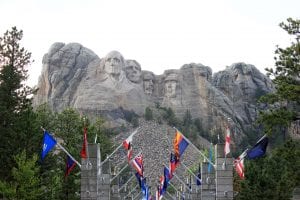
An avenue of flags greets visitors to Mount Rushmore in South Dakota. Photo by GoodFreePhotos.
The park itself is 1,278 acres at an elevation of 5,725 feet. Its claim to fame, of course, is the faces of four presidents carved into the side of a mountain.
Doane Robinson, a South Dakota historian, first suggested in 1923 that a sculpture in the Black Hills be carved as a way to enhance tourism. Mount Rushmore park was dedicated in 1925 and President Calvin Coolidge attended the 1927 dedication of the monument location.
Artist Gutzon Borglum, the son of a Belgium immigrant, was hired to oversee the project. Robinson wanted to make a sculpture out of The Needles Rock formation, but Borglum said the rock was too flimsy and Native American tribes objected.
Borglum suggested Mount Rushmore. Robinson wanted to carve the faces of American West heroes such as Lewis and Clark, Red Cloud and Buffalo Bill Cody. However, Borglum decided presidents would have broader appeal and picked George Washington, Thomas Jefferson, Abraham Lincoln and Theodore Roosevelt because they represented important times in U.S. history.
There were nearly 400 workers during the project’s lifetime. They worked from 1927 to 1941 for $8 a day, which was good money during the Great Depression. There were no fatalities despite the dangerous work that required workers to be lowered by steel cables from the top of the sculpture.
Washington’s head was finished in 1930, Jefferson in 1936, Lincoln in 1937 and Roosevelt in 1939. The chief carver was Luigi del Bianco, an Italian immigrant. Jefferson was originally supposed to be to the left of Washington but the rock was too flimsy so that was blasted away and Jefferson was carved to the right of Washington.

The partially completed Crazy Horse sculpture in South Dakota. Photo by Pxfuel.
Borglum died in March 1941 and his son Lincoln took over the project. Borglum originally wanted the sculpture to be from the waist up, but the project ran out of money in October 1941 and the sculpture was left as it is.
The stone faces are 60 feet high carved out of granite mountainside. About 450,000 tons of rock was taken out of the hillside, 90 percent of it by dynamite. The total cost was $989 million with most of the funding from the federal government.
The visitor center was opened in 1957. A museum is also there. The park gets 3 million visitors in a typical year. The entrance has the Avenue of Flags that opened in 1976. There’s also a sculptor’s studio at the visitor center as well as a 70-foot-deep Hall of Records chamber behind the faces that was cut into the back of the sculptures. The hall contains 16 porcelain enameled panels with biographies of the four presidents as well as Borglum’s biography, the history of the United States and other historical items.
A much larger sculpture of Lakota Sioux warrior Crazy Horse is being worked on in another part of the Black Hills at an elevation of 6,532 feet. The Crazy Horse Memorial has been under construction since 1948 and is far from completion. Crazy Horse’s 87-foot-high head was completed in 1998. Since then, work has been done on the 219-foot-high horse’s head. When completed, the sculpture will be 563 feet high and 641 feet long, the largest mountain carving in the world. The area also includes the Indian Museum of North America. The site gets more than 1 million visitors in a typical year. Native American Day was celebrated there in October 2021.
——————————————-
We loop back toward Rapid City to finish out our Day 50 tour.
Along the way we pass by Fort Hays Chuckwagon Supper & Show. The restaurant/theater is south of downtown Rapid City along Highway 16 and open from late May to early October. Its nightly entertainment usually begins with a free hour to explore the Dances With Wolves set and workshops that are here. Then, dinner is served with tin cups and plates. The Fort Hays Wranglers play during dinner time.
Rapid City sits on the eastern slopes of the Black Hills and is bisected by Rapid Creek. It’s the second most populous city in the state with 83,000 residents. The populace is listed as 76 percent white and 8 percent American Indian or Native Alaskan. It sits at an elevation of 3,247 feet.
The city is known as the “Gateway to the Black Hills” and the “City of Presidents.”
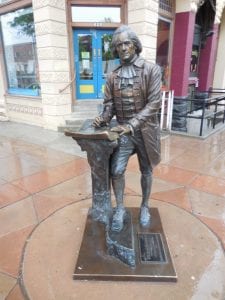
One of the many presidential statues in downtown Rapid City, South Dakota. Photo by Presidents of the United States.
Lakota and other native tribes lived in the area for centuries. The town was initially established when gold was discovered in the Black Hills by the Custer Expedition in 1874. Disappointed miners who founded the town in 1876 called it “Hay Camp” at first.
Initially, the community was a staging area for wagons headed to the Black Hills. It became a railroad hub with the completion of the Fremont, Elkhorn and Missouri Valley Railroad in 1886. There was some tourism to the Black Hills in the 1890s, but it was the advent of the automobile and new highways that brought in tourists after World War One.
Gasoline rationing hurt tourism during World War Two, but war-time activities helped the local economy. Rapid City Army Air Base was opened and renamed in 1953 as Ellsworth Air Force Base. The population of the city rose from 14,000 in 1940 to 25,000 in 1950.
In the 1950s, Nike Air Defense sites were built near Ellsworth AFB. In the early 1960s, three Titan sites with a total of nine Titan I missiles were constructed near town. By November 1963, there were 150 Minutemen silos and 15 launch command centers built within 100 miles of the city. All were decommissioned in the 1990s.
In June 1972, the Black Hills Flood of 1972 swept through town after 10 inches of rain fell in 6 hours and the Canyon Lake Dam overflowed. The flood killed 238 people and caused $160 million in property damage. A major rebuilding followed, including a 12-mile bicycle path and greenway along Rapid Creek’s banks as a memorial. Since the disaster, no construction has been permitted in the flood plain.
The city’s economy today is aided by the forestry and mining of gypsum. Clay, sand, gravel and crushed stone are still important. Cattle and sheep ranching remain active as is the farming of wheat, oats and hay.
There is a GCC Rapid City cement plant that’s been operating for 80 years. There’s also the manufacturing of Black Hills gold jewelry as well as the Black Hills Ammunition factory, which supplies military and law enforcement.
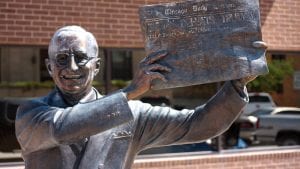
The statue of President Harry Truman in Rapid City, South Dakota. Photo by History/How Stuff Works.
Ellsworth Air Force Base is still on the outskirts of town. It’s now an Army Air Corps training base. There’s also Camp Rapid, a part of the South Dakota Army National Guard in the western sector of the city.
Tourism is a prime economic driver.
About 2.7 million visitors pass through the city in a typical year. Rapid City has a vast number of hotel rooms, so it can accommodate regional activities, including the annual Sturgis Motorcycle Rally in nearby Sturgis.
The big attraction in the town itself is the City of Presidents walking tour where you can stroll along the streets of downtown Rapid City and see a series of life-sized statues of the nation’s presidents. The program began in 2000. The statues are along Main Street and Joseph Street as well as side streets from 4th Street to 9th Street.
We can take off our walking shoes at this juncture.
Tomorrow, we head through the Nebraska panhandle on our way to a lofty city in the midst of the Rocky Mountains.

